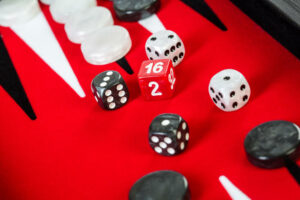European Acey Deucey is an exciting Backgammon variant and part of 3 games of Acey-Deucey (Greek Acey Deucey, European Acey Deucey, and American Acey Deucey). Acey Deucey is translated to 1-2. A roll of 1-2 has a unique meaning in European Acey-Deucey – as you will see later in this article.
How to play European Acey Deucey
The game starts with each player having 15 pieces arranged on the board in the following way:
One player will use the red pieces and the second will use the black pieces (the colors represent this example)
To begin playing European Acey Deucey, each player rolls one die, and the player with the highest roll goes first – he rolls again for his first turn. Then the play alternates.
Pieces can only be moved forward along the board toward your inner home base, It looks like this:
The basic object of the game is for players to remove all their pieces off the board before their opponents do – the first to do it is the winner!
To remove all the pieces off the board – also called bearing-off, the player must first move all his pieces into his home base, for example:
After a player successfully moves all his pieces to his home base, he can start bearing off
pieces from the board. Later in this article, we are going to talk about the European Acey Deucey bearing-off rules.
Because all the pieces are outside, you need to enter them. The entering process is responsive to the dice. You enter the piece on the opponent’s home points number according to the dice.
Unlike other Backgammon variants (like French Backgammon), you can move pieces before you enter all the other pieces. In addition, you can use one die to enter, and one die to move, or both to move or both to enter.
To move all the pieces to the home base European Acey Deucey has rules. After a player rolls the dice he can move the pieces according to the following rules (same as Backgammon):
- players need to move by each dice number, for example, if a player rolls 2 and 4, he needs to move the piece 2 and then 4, or 4 and then 2, otherwise is illegal (move one time 6 (2+4) is illegal).
- A player can move more than one piece in a single turn.
- Pieces can only be moved to open points on the board, which are points that are not occupied by two or more of the opponent’s pieces.
- Pieces can’t be removed before all pieces in the home base:
- Dice can’t be summed up. As mentioned above, a piece can be moved only by each dice number, which means dice can’t be summed up into one big move. For example, if a player rolls 1 and 2 he can’t make a big move of 3:
- If a player can’t move any piece the opponents get another turn until a move is possible.
- If a player has the option to move a piece, he has to do it! Even if only one of the dice.
- European Acey-Deucey also features doubles where both dice are matching numbers. For example, if you roll two twos. If you roll a double this is what happens:
Doubles are very rewarding in European Backgammon. If you roll a double, you start the turn like classic Backgammon – it means you play four times the dice numbers. In addition, you play the complement to 7 of the roll. The “complement to 7” refers to the difference between a number and 7. This term comes from the fact that the opposite faces of a die always add up to 7. For instance, if you rolled the dice and got two 4’s, you play four times 4, and then you also play with four 3’s in addition to the four 4’s (4 + 3 = 7).
After this, you roll again and play regularly, if you roll another double you play as mentioned above. If you can’t use any part of a roll, you lose the rest of the turn.
- In European Acey Deucey 1-2 roll is very valuable: if you rolled 1 and 2 you play the 1 and 2 regularly, and in addition, you get to choose a double to play and play it as if you rolled it – that means you play 4 times the number, then 4 time the complement to 7 and the roll again. If you can’t use any part of a roll, you lose the rest of the turn.
if your piece lands on a point where there is only one of your opponent’s pieces then they will be sent back to their bar which is essentially like being sent to jail (Like Backgammon).
To release pieces from the bar a player needs to roll the dice and hope for numbers that indicate open points at the opponent’s home base.
Once a piece is released from the bar it needs to go all the way back to your home base – so be careful!
A player must release his piece before playing with another piece!
There is no limit on the number of pieces that can be on the bar. Both players can have pieces on the bar at the same time.
- The bear-off rules are not the same as in Backgammon – you must roll the exact number to bear off.
- Pieces of both players can reach the bar even if the player started removing already.
- Once the player’s piece reaches the bar while the removal has started, the player needs to stop removing and bring back the piece to the home base. When he managed to do it, he can continue the removal.
- There are no gammons or backgammons.
- There is no doubling cube.






